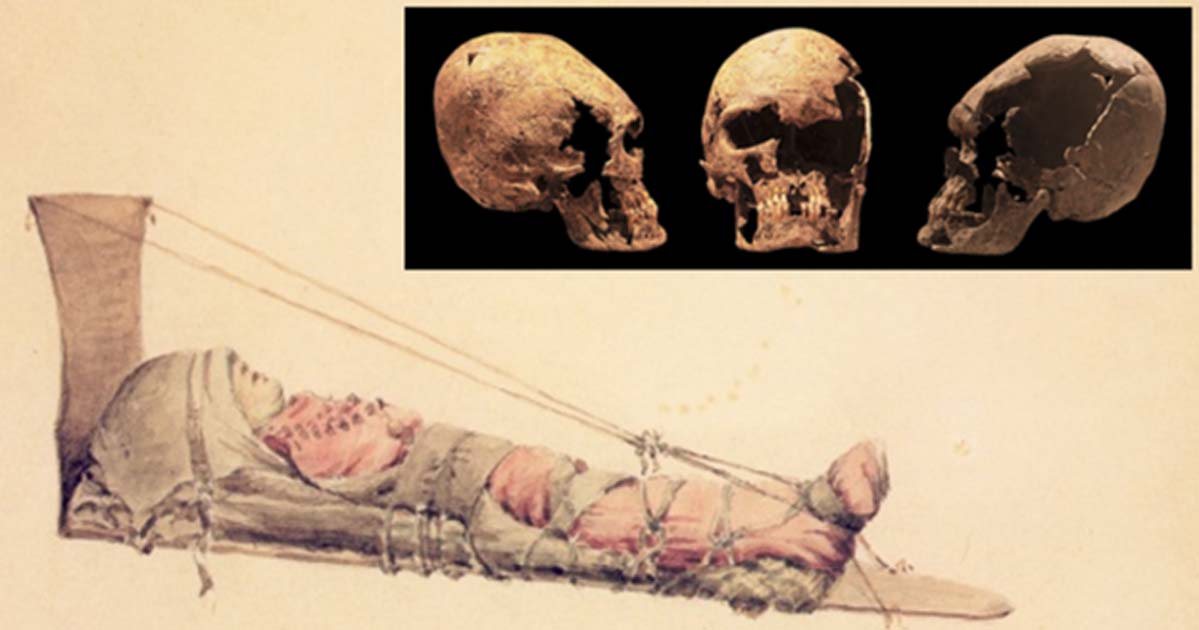Why Did Parents in the Chinookan tribe Perform Cranial Deformation on their Babies?
Beauty is a fickle thing. Worse than that, it is (as often as not) one of the most painful goals in the realms of the wealthy and elite. In China, the binding of feet was once seen to create beautiful, dainty extremities. To those in western culture, this is often viewed as a torturous activity. The Yoruba tribes of Nigeria, Benin, and Togo in Africa practice scarification: the cutting or burning of skin to create representations of familial ties. Once again, much of modern western culture would view this as a terrible childhood practice. Yet people with this perception do not realize that similar practices were performed not only in recent times, but in their own backyard. In North America one of the most prominent examples of painful beautification was the tradition of head-binding among the people of the Chinookan tribe in the Pacific Northwest.
Binding Children’s Heads to Show Nurturing and Status
In the Chinookan tribe, head binding (also known as artificial cranial deformation) occurred when an elite child, male or female, was first born, and it was the responsibility of the parents to ensure this practice was followed.
To accomplish this, the child's head was bound between wooden boards (called ‘cradle head boarding’) from the time the child turned three months old until he/she reached the one year mark. Anterior and posterior fontanels (soft spots) made it easier to shape the infant’s skull. (It should be noted, however, that this time frame is not precise, but based on archaeological analysis. The exact age this practice began and ended may have been slightly earlier or later in a child's life.)

Example of methods used by the Mayan people to shape a child's head. (Public Domain)
The cradle head boarding technique would create an inclination from the eyebrows up to the crown. A raised ridge would also be present from ear-to-ear following this practice. Essentially, the indication of a flat head not only implied a higher status (and possibly intelligence or spiritual elevation) but it was also intended to reinforce social hierarchy for the Chinookans. In their culture, people with round heads could be, and often were, enslaved - or at least looked upon with disdain. Thus, high-standing mothers were expected to perform this procedure to show that they cared for and did not neglect their children – like most mothers, they wanted them to be accepted by their peers.
- Elongated Skulls in utero: A Farewell to the Artificial Cranial Deformation Paradigm?
- New study reveal origins of elongated skulls in the Carpathian Basin
- The World-wide Mysterious Phenomena Of Elongated Skulls

Painting by Paul Kane, showing a Chinookan child in the process of having its head flattened, and an adult after the process. (Public Domain)
Hind Binding in Other Cultures
The Chinookan tribe were not the only people to participate in the performance of artificial cranial deformation. A similar ritual was performed among the Maya people, as they believed a flat, longer head was one of the more desirable traits to possess. Further, according to ancient written sources—the Classical Greek writer Hippocrates in particular—the practice was performed as far back as 400 BC, and known by other cultures around the world.

Paracas skulls. (Public Domain)
When these records are combined with archaeological data from locations such as Shanidar Cave in Iraq, this ritual appears to go as far back as the ninth millennium BC—though the actual ritualistic/societal purpose of the practice among Proto-Neolithic Homo sapiens is unknown.

‘Flat headed Indian child’. (1880) (Public Domain)
The Forgotten Story of the Chinookan Tribe
According to scholars Robert Boyd, Kenneth Ames, and Tony Johnson in their book "Chinookan Peoples of the Lower Columbia", the Chinookan people have been living on the lower portion of the Columbia in modern day Oregon for thousands of years—over 10,000 years to be a bit more precise. The English arrived in the late 1700s, and men such as Lt. William R. Broughton (18th century) and Meriwether Lewis and William Clark (19th century) recorded the Chinookan culture through their "white-man" eyes. The Chinookans were described as sedentary people living in "large, cedar plan houses", with about “25% of the area's population" enslaved by the elite and more powerful commoners.”
- Mummified Head of Newborn Baby with Extremely Elongated Skull Found in Peru
- Bizarre Alien-Like Skull Unearthed in Korea was Naturally Formed
- The 13 Alien-Like Skulls Found in Mexico

Chinook people meet the Corps of Discovery on the Lower Columbia, October 1805. (Public Domain)
The tribe was not recognized by the US government until 2001, likely why they are one of the lesser known Native American cultures. Further, the following year, when George W. Bush took presidency after Bill Clinton, this recognition was revoked. Therefore, the Chinookan tribe is not widely known or studied in United States history courses.
Top image: Chinook child undergoing process of flattening the head. (Public Domain)
By Riley Winters
References
Boyd, Robert, Kenneth Ames and Tony Johnson (eds.) Chinookan Peoples of the Lower Columbia. University of Washington Press: WA, 2013.
Smith, Cameron. "Chinookan Culture." The Virtual Meier Site. Accessed January 20, 2017. http://web.pdx.edu/~b5cs/virtualmeier/society.html
Wilson, Katie. "Recognition move by Oregon tribe stirs Chinook concerns". Chinook Observer. 2014. Accessed January 20, 2017. http://www.chinookobserver.com/co/news/20141007/recognition-move-by-oregon-tribe-stirs-chinook-concerns




















Comments
Interesting, why did it take so long to recognize them and why was the recognition revoked? Did they have a valuable claim perhaps???
This shows that the skulls they claim as Aliens skulls were actually human skulls.